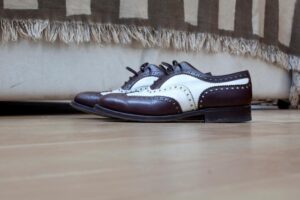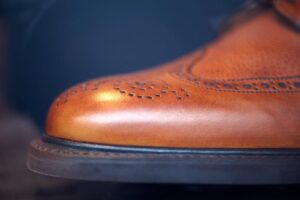When you invest in high-quality footwear, an important consideration arises: should you enhance your shoes with toe taps? Evaluating this shoe care decision is essential, as toe taps offer remarkable protection for the soles of your shoes, which can significantly reduce your future repair costs. The toe area is particularly vulnerable to wear and tear due to the natural pressure exerted during walking. While toe taps may seem like an extra expense initially, they provide durable protection for your footwear investment. Before making a final decision, take into account factors such as your walking style, how often you rotate your shoes, and the types of surfaces you frequently traverse.
Uncovering the History and Misconceptions of Toe Taps
Historically, the popularity of toe taps among discerning shoe owners has been limited, with only 10% of footwear owners opting for them prior to recent trends. Your understanding of toe taps has evolved notably since 2014, a transformative year during which many shoemakers began to incorporate pre-installed toe taps into their designs, enhancing both the functionality and appeal of their products.
Shifting Perspectives on the Use of Toe Taps
Looking back, numerous shoe enthusiasts avoided toe taps primarily due to concerns about noise. In earlier decades, many mistakenly associated toe taps with heel taps, which are known to produce more noticeable sounds while walking. This misconception led to a widespread reluctance to adopt toe taps in the early 2000s, as individuals sought quieter shoe options.
Clarifying Common Misunderstandings About Toe Taps
In addition to noise-related concerns, you might have encountered claims suggesting that toe taps could damage specific flooring types. However, it’s important to know that toe taps pose minimal risk to surfaces such as marble and untreated wood. The sound generated by metal striking concrete is less pronounced compared to heel taps, mainly because your weight is already on the ground when the toe tap makes contact.
It’s essential for you to understand that toe taps can prolong the lifespan of your shoes by up to 40% by effectively mitigating premature wear on the soles. The metal reinforcement at the toe area helps avoid expensive resoling costs, making toe taps a smart investment for your footwear, especially if you wear your shoes frequently.

Understanding How Walking Mechanics Affect Shoe Wear
Your walking mechanics are crucial in determining how your shoes wear over time. The natural walking cycle begins with a heel strike, transitions through a rolling motion in the arch, and culminates in a toe-off push. This sequence places considerable stress on specific shoe areas, especially the toe region, which is pivotal for generating forward motion and propulsion.
Identifying Critical Stress Points on Your Shoes
Your shoes experience the greatest stress at two key impact zones: the heel strike zone and the toe area. Each step begins with the heel absorbing the initial force, while the toe area endures the push-off pressure. Research has shown that around 80% of the wear on shoe soles occurs at these vital points, highlighting the necessity for effective protective measures in these regions.
Understanding Your Personal Wear Patterns
To better understand your unique wear patterns, take some time to inspect the soles of your shoes. You may notice that the toe area often shows accelerated wear within the first few weeks of use, particularly if you don’t have protective features like toe taps. Moreover, your individual walking style significantly influences the wear patterns across your footwear.
For those who regularly walk on hard surfaces, it’s not uncommon to experience complete wear-through at the toe area within just 3-6 months if protective measures are not in place. This quick deterioration can necessitate premature sole replacement, resulting in expenses that far exceed the initial investment in preventive toe tap installation.
Analyzing the Financial Benefits of Installing Toe Taps
It’s wise to evaluate the financial implications of adding toe taps to your shoes. The decision should involve weighing initial costs against potential long-term savings. Investing in toe taps can yield significant financial benefits by reducing the need for resoling, which typically ranges from $60 to $150 per pair of shoes.
Understanding the Upfront Costs of Toe Taps
When considering professional installation, toe taps typically range from $20-$40 per pair of shoes. Prices from local cobblers may vary based on the materials used for the taps and the installation technique. While this adds to the initial cost of your shoes, it represents only a fraction of the overall investment in quality footwear, which often exceeds $400.
Evaluating Long-Term Financial Advantages
To fully grasp your potential savings, consider that toe taps can extend the lifespan of your soles by as much as 50%. Without toe taps, you might need to resole your shoes every 12 to 18 months; however, with their installation, this interval can be extended to 24-36 months, depending on your specific wear habits.
The long-term financial benefits become increasingly apparent when you analyze the costs over the lifetime of your shoes. If you typically resole your shoes twice a year at a cost of $100 per service, toe taps could save you up to $100 annually for each pair. This makes them a savvy investment for your everyday footwear.
Factors to Consider When Deciding on Toe Taps
Your choice regarding toe taps depends on several key factors that significantly influence the longevity and maintenance needs of your shoes:
- Walking style and intensity
- Frequency of usage for each pair
- Type of sole material
- Investment value of your shoes
- Types of floor surfaces you commonly walk on
Understanding these elements enables you to make a well-informed decision about installing toe taps and their implications for your footwear.
Evaluating How Often You Rotate Your Shoes
At the heart of your decision to add toe taps is the frequency of wear. If you wear your shoes multiple times each week, toe taps can offer considerable protection from sole wear. The repeated action of walking creates ongoing friction in the toe area, making daily-worn shoes especially vulnerable to premature sole damage.

Assessing the Size of Your Shoe Collection
Before deciding to install toe taps, it’s critical to evaluate how many shoes you own. If you have 2-5 pairs that you regularly rotate, toe taps can provide essential protection for each pair. Given the wear and tear your shoes endure, installing toe taps becomes a justified expense.
For shoes valued at $200 or more per pair, protecting your investment should be a priority. While those with extensive collections of 100+ pairs might skip toe taps for shoes that are seldom worn, individuals with smaller collections can greatly benefit from extending the lifespan of each pair. Thus, toe taps represent a cost-effective solution for preserving your valuable footwear.
Crucial Considerations for Successful Toe Tap Installation
Once you've decided to install toe taps, it’s vital to plan for effective installation to ensure maximum protection for your shoes. This process requires a thorough assessment of your shoe’s sole condition and the careful selection of appropriate tap types. Your shoes should have sufficient sole thickness to accommodate the taps without compromising their structural integrity.
Choosing the Optimal Time for Installation
Timing is critical when it comes to installation. You can choose to install toe taps on new shoes or retrofit them onto existing footwear. For new shoes, immediate installation is the most protective approach. If considering toe taps for used shoes, ensure there’s at least 2mm of sole thickness at the toe area to facilitate safe fitting.
Selecting a Professional for Installation Services
When choosing a cobbler, it’s essential to verify their experience with toe tap installations. This process demands specialized tools and expertise to prevent potential damage to your shoes. The cost for quality installation typically ranges from $20-$40 per pair, depending on your location and the specific type of taps being used.
Even if you have a basic understanding of shoe maintenance, installing toe taps should not be a DIY job. Your selected professional should use high-quality metal taps and adhere to proper installation techniques to ensure durability. Professional installation involves accurate measurements, careful drilling, and secure mounting to avoid future issues such as loose taps.
The Significance of Surface Compatibility for Toe Taps
The types of walking surfaces you frequently encounter significantly influence the performance of toe taps and the longevity of your shoes. Different surfaces generate varying levels of friction and wear on your toe taps, making the choice of surfaces crucial for protecting both your footwear and the floors you walk on.
Identifying Compatible Surfaces for Toe Taps
Once toe taps are installed, you can confidently navigate a variety of surfaces, including concrete, asphalt, and treated wood floors. These materials provide good traction and resist damage from metal toe taps. Your daily walks on city sidewalks can become less perilous for your shoes when equipped with properly installed toe taps, potentially extending the lifespan of your soles by up to 40%.
Avoiding Surfaces That Could Damage Toe Taps
Contrary to popular belief, not all surfaces are suitable for toe taps. It’s advisable to avoid marble floors, polished stone, and untreated wooden surfaces, as toe taps can cause permanent scratches and damage to these materials.
Compatibility issues can result in substantial surface damage and potential liability. You need to be cautious, especially in historic buildings, luxury hotels, and residences with delicate flooring. Your toe taps can leave visible scratches on these surfaces, often requiring costly repairs. If your routine involves frequent visits to places with sensitive flooring, consider either removing toe taps or using protective covers.
After weighing the numerous benefits and crucial factors associated with toe taps, it becomes evident that they are a valuable enhancement to your quality footwear. If you often wear your dress shoes, toe taps can significantly prolong their lifespan by shielding the soles from premature wear. The initial financial outlay for toe taps can lead to substantial savings by reducing the necessity for regular resoling. While toe taps are particularly effective with leather soles and require caution on surfaces like marble, their practical benefits make them a compelling option for your frequently worn shoes. Ultimately, your decision will be influenced by your usage habits and the value you place on protecting your footwear investment.
The Article Are toe taps necessary? Benefits and considerations appeared first on My Shoes Finder
The Article Toe Taps: Essential Benefits and Key Considerations Was Found On https://limitsofstrategy.com

